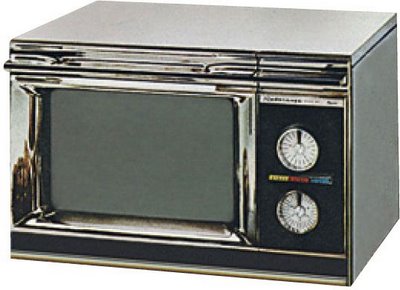First things first. This is a Radarange microwave oven from 1967. I personally believe it’s one of the most beautiful pieces of industrial design in the 20th century. While it may no longer be safe to operate one of these behemoths, I have to tell you it looks very cool. I wouldn’t mind having something that looked like that in my kitchen today.
Now, on to your regularly scheduled tutorial.
Have you ever wondered why the wi-fi drops when you’re making microwave popcorn? Or why you get static on the phone when you’re microwaving your dinner? (Contrary to the tone I’m setting here, I don’t actually microwave that much stuff, really I don’t.) The point is that the devices in your home can interfere with each other. In fact, at one point several years ago I had to replace my cordless phone (back when it was respectable to admit having one) because every time I got a call I completely lost wi-fi.
Only so much spectrum to go around
There’s a simple answer hidden within complex terms: The electromagnetic spectrum is a scarce resource. Let’s explain. Everything electric gives off some sort of electromagnetic radiation. You can shield the device to within reasonable limits but if you plug it in, it’s going to cause static at some level.
Static is unintentional radiation and there are very strict limits on that. If there weren’t, then nothing would work. Most likely your TV would cause everything else in the house to stop working, or if you turned on the computer you’d stop getting TV. Static is well understood and shielding is easy to make. Really, static isn’t your problem for the most part.
The problem is intentional radiation. In other words, the signals that are supposed to come from your router and your cordless phone. All the equipment than sends wireless signals throughout your home has to do so in a very narrow range of frequencies. This comes back to that “scarce resource” thing. It means that you can’t just pick any frequency and transmit on them. While, yes, technically there are an infinite number of frequencies that can be used, most of them are unsuitable for regular, terrestrial broadcasting and certainly not for battery-powered or low-power devices. All of your remotes, your bluetooth headset, your wireless audio device, your cordless phone (if you still have one) and your wi-fi all share a relatively small space where there’s bound to be some interference.
It gets better and worse
Whenever the FCC opens up more space (as they did when adding the 5GHz band for wi-fi or the 5.8GHz band for cordless phones) the problem gets better but only or a short time. Before you know it there are more devices that use those frequencies and you’re back to square one.
So, what about your microwave?
It, too, is an intentional radiator. Microwave ovens shoot radiation into your food to cook it from the inside. That radiation, at a frequency of 2.45GHz, is generally regarded as safe. There’s plenty of shielding around them, but keep in mind the whole purpose of a microwave is to shoot 1,000 watts of radiation out there. That’s a lot of shielding and if there’s the slightest gap then radiation can get out. Not enough to melt your eyeballs but enough to garble your wi-fi. Remember that one of the Wi-Fi bands is at 2.4GHz, not far from what the microwave is putting out. And remember, the microwave can’t be perfectly shielded. There kind of has to be a gap… or you couldn’t put food in the thing, right?
So, as with everything else in life, we compromise. We put up with a little static on the phone while making popcorn or a slight crackle in the wireless audio when using a cordless razor. Hey, it happens.





